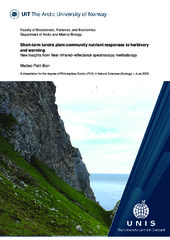| dc.contributor.advisor | Jónsdóttir, Ingibjörg Svala | |
| dc.contributor.author | Petit Bon, Matteo | |
| dc.date.accessioned | 2020-09-03T10:39:03Z | |
| dc.date.available | 2020-09-03T10:39:03Z | |
| dc.date.issued | 2020-09-22 | |
| dc.description.abstract | In the long-term, herbivores and climate warming have been shown to alter nutrient levels in tundra plant communities by changing the functional composition of the vegetation. Here, I asked the extent to which they affect tundra plant-community nutrient levels in the short-term by directly modifying the chemistry of plants.
I first developed a time- and cost-effective method that allowed me to account for the high variability in nutrient-related plant traits among plant individuals, and further scale up to the plant-community level (Paper I). Then, I applied such methodology to investigate short-term (one/two-year) plant-community nutrient-level responses to herbivores in sub-Arctic/alpine tundra-grasslands (Finnmark) and to herbivory and warming across different habitats in a high-Arctic ecosystem (Svalbard).
Herbivory and warming were key, short-term modifiers of tundra plant-community nutrient levels, thus affecting plant-community nutrient dynamics (Paper II), herbivore forage quality (Papers III, V) and the amount of nutrients available to herbivores in summer (Paper V), and the biogeochemistry of the ecosystem (Paper IV).
This thesis provides clear evidence that herbivores and climate warming cause immediate changes in tundra plant-community nutrient levels, and that these changes are happening at a much shorter time-scale than previously revealed. Considerable short-term changes in plant-community nutrient levels, as those detected in this work, are likely to have strong implications for the immediate functioning of tundra ecosystems and the trophic interactions established therein. | en_US |
| dc.description.doctoraltype | ph.d. | en_US |
| dc.description.popularabstract | Understanding and articulating how biotic and abiotic drivers affect the chemical composition of tundra plant communities is critical to predict changes in primary productivity, carbon and nutrient cycling, and herbivore forage quality. In this thesis, I asked the extent to which herbivory and climate warming affect tundra plant-community nutrient levels in the short-term. I provide clear evidence that herbivores and higher summer temperatures are key, immediate modifiers of tundra plant-community nutrient levels, and reveal that these nutrient-level changes are happening at a much shorter time-scale than previously acknowledged. Considerable short-term changes in plant-community nutrient levels, as those detected in this work, are likely to have strong implications for the immediate functioning of tundra ecosystems and the trophic interactions established therein. | en_US |
| dc.description.sponsorship | Funding for field assistance and field material was provided by the Svalbard Environmental Protection Fund (grant project number 15/128) and the Research Council of Norway (Arctic Field Grant, project number 269957) (both to Matteo Petit Bon) | en_US |
| dc.identifier.uri | https://hdl.handle.net/10037/19213 | |
| dc.language.iso | eng | en_US |
| dc.publisher | UiT The Arctic University of Norway | en_US |
| dc.publisher | UiT Norges arktiske universitet | en_US |
| dc.relation.haspart | <p>Paper I: Petit Bon, M., Böhner, H., Kaino, S., Moe, T. & Bråthen, K.A. (2020). One leaf for all: Chemical traits of single leaves measured at the leaf surface using Near infrared-reflectance spectroscopy (NIRS). <i>Methods in Ecology and Evolution, 11</i>(9), 1061-1071. Also available in Munin at <a href=https://hdl.handle.net/10037/19007>https://hdl.handle.net/10037/19007</a>.
<p>Paper II: Petit Bon, M., Inga, K.G., Jónsdóttir, I.S., Utsi, T.A., Soininen, E.M. & Bråthen, K.A. (2020). Interactions between winter and summer herbivory affect spatial and temporal plant nutrient dynamics in tundra grassland communities. <i>Oikos, 129</i>(8), 1229-1242. Also available in Munin at <a href=https://hdl.handle.net/10037/19040>https://hdl.handle.net/10037/19040</a>.
<p>Paper III: Petit Bon, M., Inga, K.G., Utsi, T.A., Jónsdóttir, I.S. & Bråthen K.A. Silicon-based defence and nutrient levels in grasses under herbivory: Forage quality in tundra grasslands is altered through different mechanisms. (Manuscript). Now published in <i>Journal of Ecology, 110</i>(1), 2022, 129-143, available in Munin at <a href=https://hdl.handle.net/10037/23156>https://hdl.handle.net/10037/23156</a>.
<p>Paper IV: Petit Bon, M., Böhner, H., Bråthen, K.A., Ravolainen, V.T. & Jónsdóttir I.S. Variable chemical responses of three major ecosystem compartments to herbivory and warming in high-Arctic tundra. (Manuscript). Now published in <i>Ecosphere, 2</i>(9), 2021, e03746 , available in Munin at <a href=https://hdl.handle.net/10037/23628>https://hdl.handle.net/10037/23628</a>.
<p>Paper V: Petit Bon, M., Bråthen, K.A., Ravolainen, V.T., Böhner, H. & Jónsdóttir, I.S. Nutrient contents and nutrient pools of high-Arctic plant communities: contrasting effects of herbivory and warming and plant functional type dependent responses. (Manuscript). | en_US |
| dc.relation.projectID | info:eu-repo/grantAgreement/RCN/SSF/269957/Norway/Effects of herbivory and warming on tundra plant communities// | en_US |
| dc.rights.accessRights | openAccess | en_US |
| dc.rights.holder | Copyright 2020 The Author(s) | |
| dc.rights.uri | https://creativecommons.org/licenses/by-nc-sa/4.0 | en_US |
| dc.rights | Attribution-NonCommercial-ShareAlike 4.0 International (CC BY-NC-SA 4.0) | en_US |
| dc.subject | VDP::Mathematics and natural science: 400::Zoology and botany: 480::Ecology: 488 | en_US |
| dc.subject | VDP::Matematikk og Naturvitenskap: 400::Zoologiske og botaniske fag: 480::Økologi: 488 | en_US |
| dc.title | Short-term tundra plant-community nutrient responses to herbivory and warming: New insights from Near infrared-reflectance spectroscopy methodology | en_US |
| dc.type | Doctoral thesis | en_US |
| dc.type | Doktorgradsavhandling | en_US |


 English
English norsk
norsk

